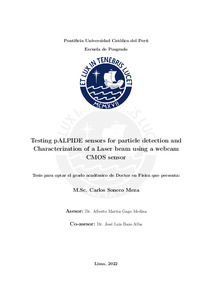| dc.contributor.advisor | Gago Medina, Alberto Martín | |
| dc.contributor.author | Soncco Meza, Carlos | |
| dc.date.accessioned | 2023-01-16T15:00:14Z | |
| dc.date.available | 2023-01-16T15:00:14Z | |
| dc.date.created | 2022 | |
| dc.date.issued | 2023-01-16 | |
| dc.identifier.uri | http://hdl.handle.net/20.500.12404/24005 | |
| dc.description.abstract | The upgrade program of the Large Hadron Collider (LHC) was implemented during the second Long Shutdown program (2019/2020). For this program, the ALICE Collaboration (A Large Ion Collider Experiment) proposed, among others, a new detector called Muon Forward Tracker (MFT). The primary goal of the MFT detector, installed on December 2021 and located between the Inner Tracker System (ITS) and the Muon Spectrometer, is to improve the capability of vertex reconstruction. The MFT is equipped with the same pixel sensors used for the ITS upgrade. These sensors are the ALICE Pixel Detectors (ALPIDE), a kind of monolithic active pixel sensor. The MFT is composed of five arrays of pixel sensors which are configured as parallel discs covering −3.6 < η < −2.45. Some prototypes were designed in order to achieve the final version of the ALPIDE, such as the pALPIDE family, which was divided into three versions (i.e., pALPIDE-1,2,3). The ALICE upgrade also included a new system for the data taking and simulation called Online-offline (O2) to replace AliRoot. We designed the geometry of two non-active parts of the MFT and included them in the O2 system. The first goal of this thesis is focused on the characterization of the pALPIDE-2. This sensor is segmented into four groups corresponding to four types of pixels. This characterization includes the test of analogue and digital. According to these tests, we identified a group of pixels that do not work correctly. The threshold scan tests showed the threshold level in each pixel is influenced by the input capacitance according to its n-well size and the surrounding area. Also, we studied the response of the pALPIDE-2 when it was exposed to a soft x-ray source, varying the distance between them. This test showed that the hit count changed according to the inverse square of the distance. iv The second goal of this thesis was to implement a low-cost tool based on a CMOS sensor to characterize laser beams. This tool comprises a Raspberry, a Pi Camera with a pitch size of 1.4 µm, and an optical system. To test the accuracy of the results of this tool, we made similar measurements with other sensors. A photodiode and a light-dependent resistor performed these measurements, which showed the spot radius size compatibility. However, the CMOS sensor expressed the highest precision and is a more affordable tool than commercial devices. | es_ES |
| dc.language.iso | eng | es_ES |
| dc.publisher | Pontificia Universidad Católica del Perú | es_ES |
| dc.rights | info:eu-repo/semantics/openAccess | es_ES |
| dc.rights.uri | http://creativecommons.org/licenses/by-sa/2.5/pe/ | * |
| dc.subject | Colisiones de hadrones | es_ES |
| dc.subject | CMOS (Electrónica) | es_ES |
| dc.subject | Lásers en física | es_ES |
| dc.title | Testing pALPIDE sensors for particle detection and Characterization of a Laser beam using a webcam CMOS sensor | es_ES |
| dc.type | info:eu-repo/semantics/doctoralThesis | es_ES |
| thesis.degree.name | Doctor en Física | es_ES |
| thesis.degree.level | Doctorado | es_ES |
| thesis.degree.grantor | Pontificia Universidad Católica del Perú. Escuela de Posgrado | es_ES |
| thesis.degree.discipline | Física | es_ES |
| renati.advisor.dni | 07835422 | |
| renati.advisor.orcid | http://orcid.org/0000-0002-0019-9692 | es_ES |
| renati.author.dni | 41605742 | |
| renati.discipline | 533018 | es_ES |
| renati.juror | Uras, Antonio | es_ES |
| renati.juror | Gago Medina, Alberto Martin | es_ES |
| renati.juror | Ortiz Cabello, Omar Hernan | es_ES |
| renati.level | https://purl.org/pe-repo/renati/level#doctor | es_ES |
| renati.type | https://purl.org/pe-repo/renati/type#tesis | es_ES |
| dc.publisher.country | PE | es_ES |
| dc.subject.ocde | https://purl.org/pe-repo/ocde/ford#1.03.00 | es_ES |







